Illuminated Manuscripts › The Roman-Parthian War 58-63 CE › Tigranocerta » Origins and History
Articles and Definitions › Contents
- Illuminated Manuscripts › Origins
- The Roman-Parthian War 58-63 CE › Origins
- Tigranocerta › Origins
Ancient civilizations › Historical places, and their characters
Illuminated Manuscripts › Origins
Definition and Origins
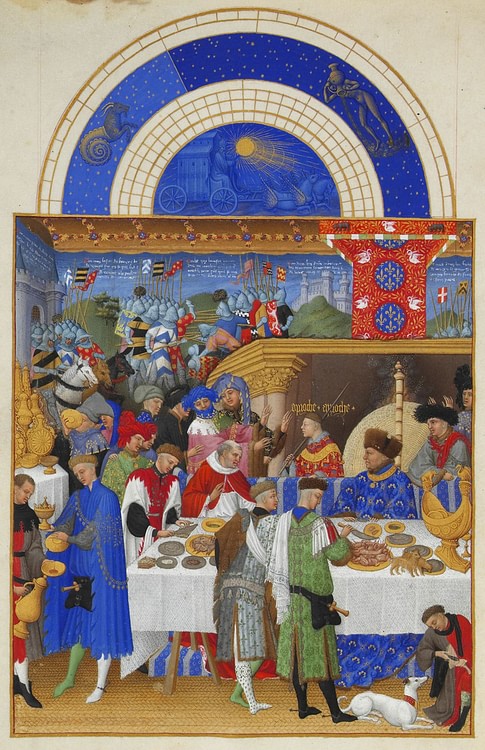
Illuminated manuscripts were hand-made books, usually on Christian scripture or practice, produced in Western Europebetween c. 500-c. 1600 CE. They are so called because of the use of gold and silver which illuminates the text and accompanying illustrations. Although Muslim artisans also used this technique to ornament their books, the term “illuminated manuscripts” is most commonly used to refer to those works produced in Europe on Christian themes. However, the poetry and myth of pre-Christian authors, such as Virgil, was sometimes also illuminated.
Hand-made illuminated manuscripts were initially produced by monks in abbeys but, as they became more popular, production became commercialized and was taken over by secular book-makers. Illuminated manuscripts were quite costly to produce and only those of significant means could afford them. The most popular type was the Book of Hours which was a Christian devotional of prayers to be said at certain times throughout the day. More Books of Hours have survived than any other work of the period simply because more of them were produced. The invention of the printing press by Johannes Gutenberg in c.1440 CE signaled the beginning of the end of hand-made books generally and illuminated manuscripts specifically.
A BRIEF HISTORY OF BOOKS
The written word was invented in Sumer, southern Mesopotamia, around 3500-3000 BCE, where clay tablets were used to convey information. The Egyptians began using papyrus scrolls by the Early Dynastic Period (c. 3150-c. 2613 BCE) which were adopted by the Greeks and Romans, although these latter two also began to use writing tablets of wood covered with wax. Several such tablets could be bound together between covers of wood or metal to form a single volume; this was called a codex and it replaced the papyrus scroll in the Mediterranean region c. 400 CE.
FROM THE 5TH-13TH CENTURY CE MONASTERIES WERE THE SOLE PRODUCERS OF BOOKS. MONKS WERE INVOLVED IN EVERY ASPECT OF THEIR PRODUCTION FROM PROCESSING THE VELLUM TO THE FINAL PRODUCT.
Paper was invented in China by Ts'ai Lun (also given as Cai Lun, 50-121 CE) during the Han Dynasty in c. 105 CE, and was introduced into the Arab world by Chinese merchants in the 7th century CE. The cities of Baghdad and Damascus, especially, became important centers of paper and book production and Muslim writers began producing original works of literature and poetry, as well as treaties on mathematics, science, astrology, and philosophy. They also made extensive copies of western philosophers like Aristotle (384-322 BCE) which preserved many of his works long before they were appreciated in the west.Muslim artisans decorated their books with elaborate borders and illustrations and these are often defined as illuminated manuscripts.
In Europe, however, the acceptance of paper was still centuries away. The Chinese had been using paper for almost a century when people in Asia Minor developed writing surfaces made of animal hides (sheep or goats) which were soaked in water, scraped to remove hair, stretched on wooden frames to dry, and then bleached with lime; the finished product became known as parchment.
Parchment made of calfskin was called vellum, was of much higher quality as a writing surface, and so became more popular.European monks favored vellum and this became their standard material for the works which would become known as illuminated manuscripts. Paper and papyrus were considered un-Christian by the medieval church and their use was discouraged as these materials had been used by pagan writers in the past and were used by “heathens” of the east at this time. Paper would not be accepted by Europeans until the 11th century CE.

Lindisfarne Gospels
HOW THEY WERE MADE
As books became more popular, they were produced by secular merchants and sold in books stalls and stores. Initially, however, they were made by monks in monasteries, abbeys, and priories probably first in Ireland and then Britain and the continent.
Every monastery was required to have a library according to the rules of St. Benedict of the 6th century CE. Some books no doubt arrived with the monks who came to live there but most were produced at the site by monks known as scriptores in rooms called scriptoriums. From the 5th to the 13th century CE monasteries were the sole producers of books. The scriptorium was a large room with wooden chairs and writing tables which angled upwards to hold manuscript pages. Monks were involved in every aspect of a book's production from processing the vellum to the final product.
A director would distribute pages to be done to the monks in the room and then remain to supervise and maintain the rule of silence. Scribes worked only in the day and could not have candles or lamps near the manuscripts for fear of fire. The director would make sure that the monks remained at work, quietly, and continued until their pages were done. One monk rarely worked on a page to completion but rather traded with others in the room.
A monk would begin by cutting down a sheet of vellum to appropriate size. This practice would dictate the shape of books down to the present day as longer than they are wider. Once the vellum sheet was prepared, lines would be ruled across it for text and blank spaces left open for illustrations.
THE PAGES OF THE CODEX ARGENTEUS WERE DYED PURPLE, TO DENOTE THE ELEVATED SUBJECT MATTER, AND THE WORK WAS WRITTEN & ILLUSTRATED IN SILVER & GOLD INK.
The text was written first in black ink (or gold or another appropriate color for the subject) between the ruled lines on the page and then would be given to another monk to proofread for errors; this second monk – or perhaps a third – would then add titles in blue or red ink and then pass the page on to the illuminator who would add images, color, and the requisite gold illumination.Monks wrote with quill pens and boiled iron, tree bark, and nuts to make black ink; other ink colors were produced by grinding and boiling different natural chemicals and plants.
The work was long and tedious, carried out in the silence of rooms lit only by narrow windows which were cold in winter and sultry in warmer weather. A scriptore-monk was expected to show up for work no matter the weather, their state of health, or interest in a project. It is clear, from brief comments written on some pages, that the monks were not always happy about their duties.
Scholar Giulia Bologna notes how many manuscripts include small notations written in the margins such as “This page was not copied slowly”, “I don't feel well today”, “This parchment is certainly hairy” and a long observation regarding having to sit for hours hunched over a writing table: “Three fingers write, but the entire body toils. Just as the sailor yearns for port, the writer longs for the last line” (37).
THE EARLY ILLUMINATED MANUSCRIPTS
The vellum works of Europe became the standard definition of a book for centuries. The word book comes from the Old English boc meaning 'a written document' or 'written sheet' and the texts produced on vellum in time came to be decorated with flourishes and illustrations. The earliest illuminated manuscript is the Vergilius Augusteus of the 4th century CE which exists in seven pages of what must have been a much larger book of Virgil's works.
It is not technically an illuminated manuscript because it makes no use of gold, silver, or any colored illustrations but it is the oldest European work which uses decorated capital letters to begin each page - a practice which would come to define illuminated manuscripts.
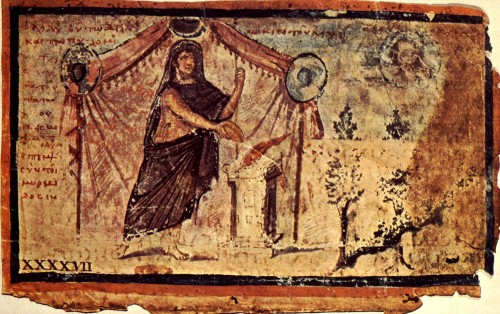
Ambrosian Iliad
In the 5th century CE, the Ambrosian Iliad, an illuminated manuscript of Homer ’s work, was completed, most likely in Constantinople. This work is richly illustrated and the technique used seems to have influenced later artisans. The St. Augustine Gospels of the 6th century CE, another illuminated work, shows similarities to the earlier Iliad. The St. Augustine Gospels is a copy of the four gospels as translated by St. Jerome and was once completely illustrated but many of the pieces have been lost over time.
One of the most impressive of the early illuminated manuscripts is the Codex Argenteus ('Silver Book”) of the 6th century CE which is a copy of the Bishop Ulfilas' translation of the Bible (c. 4th century CE) into the Gothic language. The vellum pages were dyed purple, to denote the elevated subject matter, and the work was written and illustrated in silver and gold ink. It is commonly accepted that the book was produced for the Gothic king Theodoric the Great (r. 493-526 CE) in Italy.
FAMOUS ILLUMINATED MANUSCRIPTS
The greatest works were created between the 7th – 16th centuries CE when the basics of illustration and decoration had been mastered and were perfected. Among these works, the best known is the Book of Kells, currently housed at Trinity College, Dublin, Ireland, created c. 800 CE.
The Book of Kells was produced by monks of St. Columba's order of Iona, Scotland but exactly where it was made is uncertain. Theories regarding its composition range from its creation on the island of Iona, to Kells in Ireland, to Lindisfarne in Britain. It was most likely created, at least in part, at Iona and then brought to Kells to keep it safe from Viking raiders who first struck Iona in 795 CE, shortly after their raid on Lindisfarne Priory in Britain.
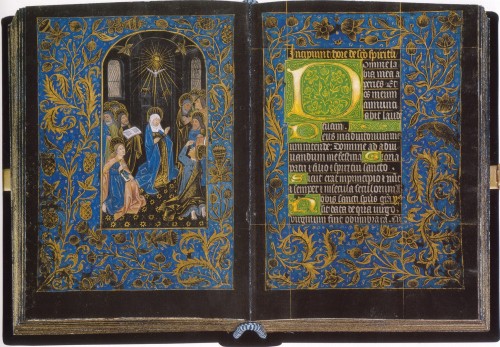
Black Hours
A Viking raid in 806 CE killed 68 monks at Iona and led to the survivors abandoning the abbey in favor of another of their order at Kells. It is likely that the Book of Kells traveled with them at this time and may have been completed in Ireland. The grandeur of this work is justly praised but it should be noted that there are many other high-quality illuminated manuscripts currently housed in private collections, museums, and libraries around the world. Among these many, some of the most impressive are:
The Book of Durrow (650-700 CE) – The oldest illuminated book of the gospels created either at Iona or Lindisfarne Abbey. It contains a number of striking illustrations including carpet pages of intricate Celtic -knot motifs with various animals entwined.
Codex Amiatinus (c. late 7th – early 8th century CE) – The oldest version of St. Jerome's Vulgate Bible. It was created in Northumbria, Britain, and although it is not technically “illuminated” it does contain a number of significant full-page illustrations and miniatures.
Lindisfarne Gospels (c. 700-715 CE) – Among the best-known and most admired illuminated manuscripts, this work was created at the Lindisfarne Priory on the “Holy Island” off the coast of Dorset, Britain. It is an illustrated edition of the gospels of the New Testament made in honor of the priory's most famous member, St. Cuthbert.
The Morgan Crusader Bible (c. 1250 CE) – Created in Paris most likely for Louis IX (1214-270 CE) whose piety was a defining characteristic of his reign. It was originally a work only of full-color illuminated illustrations of Old Testament events and lay subjects but later owners commissioned accompanying text to the images. The work is considered one of the greatest illuminated manuscripts and a masterpiece of medieval art.
The Westminster Abbey Bestiary (c. 1275-1290 CE) – Probably created in York, Britain, this work is a collection of descriptions of animals – some real and some imaginary – drawn from pre-Christian sources, the Bible, and legends. There were a number of bestiaries produced during the middle ages but the Westminster Abbey Bestiary is considered the finest for the skill of composition of the 164 illustrations it contains.
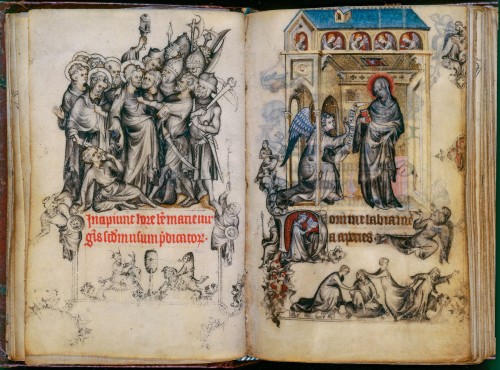
Book of Hours of Jeanne d'Evreux
The Book of Hours of Jeanne d'Evreux (c. 1324-1328 CE) – Created in Paris, France by the leading illustrator of the time, Jean Pucelle, for the queen Jeanne d'Evreux (1310-1371 CE), wife of Charles IV (1322-1328 CE). It is a small Book of Hours delicately illustrated on exceptionally fine vellum with over 700 illustrations accompanying the text. The work is smaller than a modern-day paperback and must have required great skill to produce.
The Black Hours (c. 1475-1480 CE) – Created in Bruges, Belgium by an anonymous artist working in the style of the leading illustrator of the city, Wilhelm Vrelant who dominated the art from c. 1450 until his death in 1481 CE. It is made of vellum which was stained black and illuminated in striking blue and gold. The text is written in silver and gold ink. It is one of the most unique Books of Hours extant.
Les Tres Riches Heures du Duc de Berry (c. 1412-1416 and 1485-1489 CE) – The most famous Book of Hours in the present day as well as its own time, this work was commissioned by Jean, Duke of Berry, Count of Poitiers, France (1340-1416 CE). It was left unfinished when the Duke as well as the artists working on it died of the plague in 1416 CE. The work was discovered and completed between the years 1485-1489 CE when it was recognized as a masterpiece. It is frequently referred to as the “king of illuminated manuscripts” because of the grandeur and intricacy of the paintings.
Grimani Breviary (c. 1510 CE) – An enormous work of 1,670 pages with full-page illustrations of scenes from the Bible, secular legend, contemporary landscapes and domestic scenes. The text is made up of prayers, psalms, and other selections from the Bible. It was probably made in Flanders but who created or commissioned it is unknown. The book was bought by the Venetian Cardinal Domenico Grimani (1461-1523 CE) in 1520 CE who declared it so beautiful that only select people of high moral standing should be allowed to see it and then only under special circumstances.
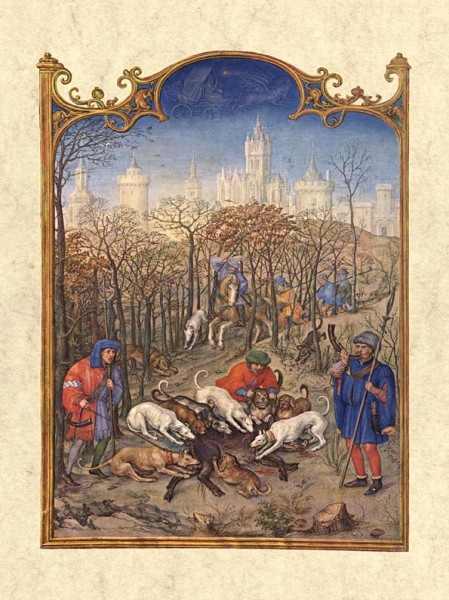
Grimani Breviary
Prayer book of Claude de France (c. 1517 CE) – One of the most unique and impressive illuminated manuscripts, this book is small enough to fit in the palm of one's hand and yet is illustrated with 132 brilliantly realized works framed by elaborate and striking borders. The little book was made for Claude, queen of France (1514-1524 CE) along with a Book of Hours by an artist who was known, after completing these works, as Master of Claude de France.
THE PRINTING PRESS & THE END OF ILLUMINATION
By the 13th century CE, literacy in Europe had improved and professional book-makers appeared on the scene in response to demand. In Britain, literature produced in vernacular languages had been encouraged since the reign of Alfred the Great (871-899 CE) and, in France, since the time of Charlemagne (800-814 CE). The greater demand led to the necessity for more scribes and many of these were women.
That both men and women were now involved in book production is clear from their known places of origin (such as nunneries rather than monasteries) as well as the same kind of notations the monks left on pages. Scholar Christopher de Hamel notes one such instance:
It is frequently said that women had an important role in promoting vernacular writing [English] because girls were not customarily taught Latin as thoroughly as boys. It is quite true that vernacular prayer books can often be traced to nuns rather than monks, for example…In fact the earliest dated Lancelot manuscript must have been written by a female scribe. It was made in 1274 and ends with the request that the reader will pray for the scribe, `pries pour ce li ki lescrist'; `ce li' is a feminine pronoun. (148)
Books continued to be produced by hand until the invention of the printing press by Johannes Gutenberg in c. 1440 CE. By 1456 CE, he had printed the Latin Bible – now commonly referred to as the Gutenberg Bible – and the process of printing books instead of crafting them by hand was mastered.
Shortly after this, Gutenberg's press and equipment were seized for outstanding debts and Gutenberg's patron, Johann Fust, developed the printer's techniques successfully to mass produce written works. A single book of approximately 400 pages would have once taken at least six months to produce; now it could be printed in less than a week.
Even so, people then – as now – liked what they knew and many rejected the new product of the printed book. Giulia Bologna notes how “the great bibliophile Federigo da Montefelto, Duke of Urbino, would have felt shame to have had a printed book in his library” (39). Printed books were at first considered cheap imitations of “real books” and printers, recognizing this, went to lengths to make them look like hand-made works of the past by binding them in leather, adding gold gilt to the covers, and hiring illustrators to provide images for the text. These practices helped make the new products more palatable to book collectors. Still, illuminated manuscripts were commissioned, though in far fewer numbers than in the past, up through the early years of the 17th century CE.
As the printed book became more widely accepted, however, the skills of illumination were valued less and less and eventually were forgotten. The work of the artists - most of them anonymous - would live on, however, in the books they had created.Illuminated manuscripts were intentionally crafted as valuable items from their beginning but became more so once they were no longer produced. The wealthy sought out these books and cultivated collections in their private libraries which preserved the works up through to the present day.
The Roman-Parthian War 58-63 CE › Origins
Ancient Civilizations
The Roman -Parthian War of 58-63 CE was sparked off when the Parthian Empire ’s ruler imposed his own brother as the new king of Armenia, considered by Rome to be a quasi-neutral buffer state between the two empires. When Parthia went a step further and declared Armenia a vassal state in 58 CE all-out war broke out. The on-off war, in which the Roman commander Corbulo excelled, would only be settled in 63 CE with the Treaty of Rhandia which shared the responsibility of ruling Armenia between the two powers.
THE ARMENIAN THRONE
Tiridates I of Armenia (rc 63 to 75 or 88 CE) was the brother of the Parthian king Vologases I (aka Vagharsh, rc 51- up to 80 CE, dates disputed) who invaded Armenia in 52 CE for the specific purpose of setting Tiridates on the throne. The Roman Empire was not, though, content to passively permit Parthia into what they considered a buffer zone between the two great powers. Nor was it willing to accept the consequent dent in Roman pride and prestige. Further, an embassy arrived in Rome which represented the pro-Roman faction in Armenia and they asked for direct assistance. Consequently, Roman emperorNero (r. 54-68 CE) sent an army in 54 CE to at the very least restore the status quo. The commander given the task was Gnaeus Domitius Corbulo, Rome's best general at the time.

Parthian Archer
Corbulo, a man of imposing stature, had gained his reputation fighting in Germany to restore Roman influence in the region.The modern historian M. Lovano gives the following summary of the Roman historian Tacitus' (c. 56 - c. 120 CE) description of Corbulo:
His greatest hero in the Annals is definitely Corbulo, victor over the Parthian menace. Corbulo is capable of great physical endurance, is as hard-working as he expects his men to be, encouraging and solicitous of their well-being, but also tough with discipline, and cautious and very thorough in preparation for and execution of battle.(in Campbell, 87)
Corbulo was made governor of Cappadocia and Galatia, and given the task of securing both Syria and the small kingdom south of Armenia, Sophene (Dsopk) to beef up Rome's presence in the region and remind Parthia who they were up against.The general, famed as a strict disciplinarian, also reorganised the Roman army in the east - clearly, he was preparing for a significant campaign. The precautions taken before an outright battle with Parthia may well have been because the last time the two sides had fought, at the battle of Carrhae in 53 BCE, the Romans had suffered a disastrous defeat and their commander Marcus Licinius Crassus had lost his head as well as his army.
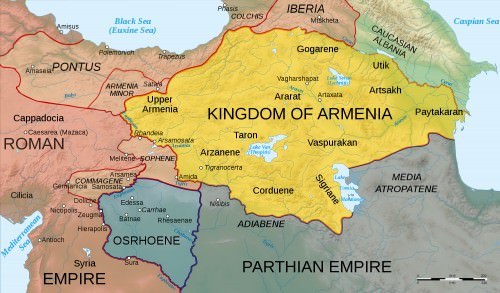
Map of Armenia, 50 CE
The Romans, then, were all too familiar with the Parthian strategy of avoiding close combat and relying on their skill as horse-riders able to fire their bows even behind them while still on the move - the famous “Parthian shot”. The Roman army's strength was a full-on battle of large set-pieces where discipline and teamwork made the manoeuvres of the legions a formidable weapon in itself. The Parthians, though, favoured a more mobile approach to warfare with the use of feigned retreats to lull their enemy into a disordered pursuit. As a result, the campaign for control of Armenia was never going to be a short one.
WHEN PARTHIA DECLARED ARMENIA A VASSAL STATE IN 58 CE, CORBULO MOVED NORTHWARDS & ATTACKED ARMENIA ITSELF.
When Parthia declared Armenia a vassal state in 58 CE, Corbulo moved northwards and attacked Armenia itself. If the Roman general could not pin down the enemy on the battlefield he could at least attack stationary targets like cities and fortresses. By the time the Romans arrived in Tiridates' kingdom, Vologases had been forced to withdraw to deal with internal troubles in Parthia, but Tiridates remained at the Armenian capital of Artaxata (Artashat). Tiridates was actually supported by most of the Armenian people who were more sympathetic to Parthia than to Rome for historical and cultural reasons.
Corbulo proved again to be a very capable field commander and with logistical support from Roman ships at Trebizond and other ports on the Black Sea, he took and destroyed Artaxata. Corbulo's strategy was clearly to cause as much terror as possible in the Armenian people and so dissuade them from assisting Parthia or resisting Roman force. Indeed, such was Corbulo's reputation for taking and destroying forts and settlements that the inhabitants of Artaxata opened the city gates and surrendered without a fight. It is also worth noting that the commander first let the non-combatants flee the city before he torched it, a decision based on the belief that he did not have a sufficient force to hold the city and continue the campaign at the same time.

Map Roman-Parthian War, 58-60 CE
Tigranocerta, the second most important fortress city, soon fell to the Romans in similar circumstances:
Soon afterwards, Corbulo's envoys whom he had sent to Tigranocerta, reported that the city walls were open, and the inhabitants awaiting orders. They also handed him a gift denoting friendship, a golden crown, which he acknowledged in complimentary language. Nothing was done to humiliate the city, that remaining uninjured it might continue to yield a more cheerful obedience. (Tacitus, Annals, Bk. 14:24)
With these successes and others, by 60 CE, Corbulo could claim to rule over all of the Kingdom of Armenia and Tiridates was forced to flee back to his brother in Parthia. In the same year, Tigranes V (rc 60-61 CE), who had impressive royal connections being the grandson of Herod the Great, was set on the throne as a pro-Roman monarch. Corbulo, meanwhile, was made governor of Syria, but the job was not yet finished.
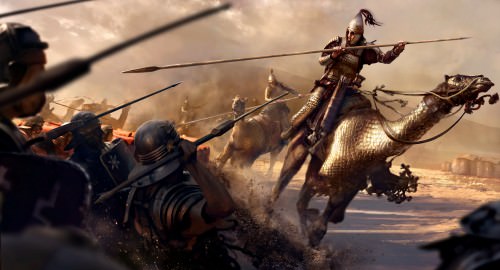
Parthian Camel Cataphracts
Tigranes V's cameo reign came to an abrupt end when the Parthians sent an army to besiege him in Tigranocerta. In 62 CE at Rhandia a joint Armenia-Parthia army with its famous mailed cavalry and horse archers won a victory against a Roman army which, significantly perhaps, was no longer commanded by Corbulo but the rather less accomplished Caesennius Paetus.Paetus, inadequately defending his winter army camp and regularly tempted into forays which overstretched his supply lines, capitulated to the Parthians on disgraceful terms and was dismissed for his troubles by Nero.
In 63 CE Corbulo, now responsible for all of Cappadocia-Galatia and Syria, was given maius imperium or supreme command in war. He was to return to Armenia to rescue and restore the standards of the legions under the command of Paetus and Roman ambitions in general in the region:
Corbulo, perfectly fearless, left half his army in Syria to retain the forts built on the Euphrates, and taking the nearest route, which also was not deficient in supplies, marched through the country of Commagene, then through Cappadocia, and thence into Armenia. Beside the other usual accompaniments of war, his army was followed by a great number of camels laden with corn, to keep off famine as well as the enemy. ( Ibid, Bk. 15:12)

Map of the Roman-Parthian War, 61-63 CE
With his objective achieved, Paetus' beleaguered troops were sent back to Syria to recuperate while Corbulo prepared for one final offensive in Armenia. The commander,
...led thence into Armenia the third and sixth legions, troops in thorough efficiency, and trained by frequent and successful service. And he added to his army the fifth legion, which, having been quartered in Pontus, had known nothing of disaster, with men of the fifteenth, lately brought up, and picked veterans from Illyricum and Egypt, and all the allied cavalry and infantry, and the auxiliaries of the tributary princes, which had been concentrated at Melitene, where he was preparing to cross the Euphrates. ( Ibid, Bk. 15:26)
The threat of Corbulo once again in the field was sufficient for the Parthians to withdraw, and the Treaty of Rhandia was drawn up (named after the site in western Armenia). It was now agreed that Parthia had the right to nominate Armenian kings, Rome the right to crown them, and both powers would rule equally over Armenia with the king as their representative. Nero was thus given the privilege of crowning Tiridates in Rome in a lavish spectacle that did much to show the power and global reach of the Roman Empire.

Statue of Corbulo
AFTERMATH
In 66 CE Tiridates travelled to the great city of Rome to receive his crown from Nero in one of the most extravagant public spectacles the Eternal City had ever witnessed. Corbulo, on the other hand, was suspected of treason - or more precisely his son-in-law was - and invited to commit suicide in October of the same year. It was a strange twist of fate that the victor and loser on the battlefield would see such a complete turnaround in their fortunes. Before he died, Corbulo wrote an account of the conflict, his commentarii, which formed the basis for later writers such as Tacitus. Corbulo's prestige in the army never wavered despite his political downfall, which perhaps explains emperor Vespasian ’s (r. 69-79 CE) motivation for arranging a marriage between his son Domitian (r. 81-96 CE)and Corbulo's daughter Domitia Longina.
The wars against Parthia had been costly for the Romans, as is indicated by the reduction in the percentage of gold and silver in Roman coins of the period. The rivalry and disputes between Parthia and Rome would not go away either, and the two empires continued to clash until the early 3rd century CE.
This article was made possible with generous support from the National Association for Armenian Studies and Researchand the Knights of Vartan Fund for Armenian Studies.
Tigranocerta › Origins
Definition and Origins

Tigranocerta (Tigranakert) was a city in the southwest of ancient Armenia founded and made capital by Tigranes the Greatin 83 BCE. Famous for its riches and fine buildings, as well as its mix of Hellenistic and Persian culture, the city, despite possessing impressive fortifications, was captured twice by Roman armies in 69 BCE and 59 CE. Continuing as an important settlement into Late Antiquity, it was then abandoned and its precise location has been lost in the mists of time.
FOUNDATION
One of the greatest of the Artaxiad kings, or indeed any Armenian king, was Tigranes II (Tigran II) or Tigranes the Great (rc 95 - c. 56 BCE). He expanded his kingdom considerably and at its peak, the Armenian Empire stretched from the Black Sea to the Mediterranean. Not before or since would Armenians control such a huge swathe of Asia. Tigranes was noted as an admirer of Greek culture - not insignificantly, his wife was Cleopatra of Pontus - and he followed the Hellenistic trend of rulers founding a new city and naming it after themselves. Tigranocerta, meaning “Tigranes' foundation”, was founded in 83 CE and it was made the capital city of the new empire of Armenia.
TIGRANOCERTA HAD IMPRESSIVE FORTIFICATIONS WITH THE WALLS REACHING A HEIGHT OF 22-26 METRES.
Due to a lack of any archaeological evidence, the precise location of the city is not known beyond that is was somewhere in the southwest of ancient Armenia, which was a more central position than the old capital of Artaxata (Artashat) given the kingdom's recent expansion. It was probably located along the River Tigris on the Persian Royal Road trade route with two possible candidates being near modern Diyarbakir or Siirt (both in today's southeast Turkey ). An added advantage was that the location in the south was much closer to the newly acquired and immensely rich territory of Syria. One of the negative aspects of the new location was its vulnerability to attack and relative isolation from the Armenian heartland - a fact which would be twice exploited by Roman field commanders.
A COSMOPOLITAN CITY
Tigranocerta was famously Hellenistic in its architecture although it was specifically designed to reflect the mixed cultural heritage of the country with Greek, Persian, and Armenian elements. The city had impressive fortifications with the walls reaching a height of 22-26 metres and incorporating stables, such was their thickness. There were also many amenities including a Greek theatre, a palace built in the Persian style outside the city walls, a fort, hunting parks and pleasure gardens.Tigranes was said to have forcibly relocated (a traditional figure of) 300,000 people to the new capital form 12 different cities, most of them in Cappadocia. According to the 1st-century BCE Greek historian and geographer Strabo, the largest contingent of forced migrants came from Mazaka in Cappadocia.
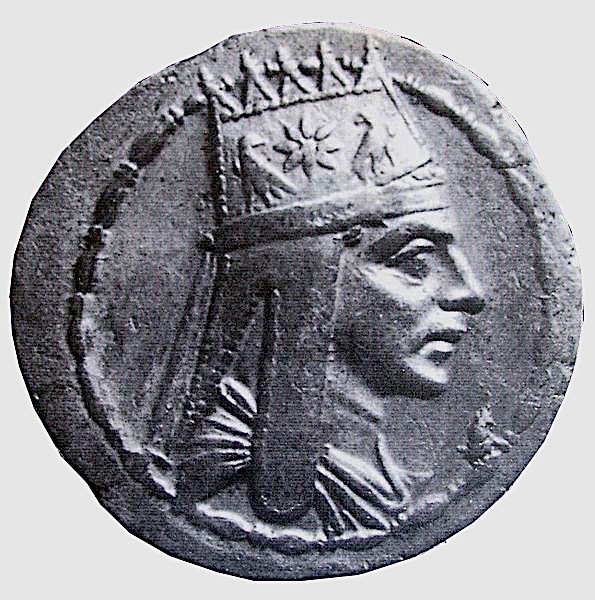
Tigranes the Great
As the centre of a prospering empire with trade links to both Mesopotamia and Phoenicia, material wealth flooded into the city from all directions, as the 1st-2nd-century CE Greek historian Plutarch here notes:
…the city was also full of wealth…since every private person and every prince vied with the King in contributing to its increase and adornment. ( Lucullus, 26:2)
The fabled wealth of Tigranocerta at this time was still dazzling historians writing in the 5th century CE, as in this description of Tigranes by the Armenian historian Movses Khorenatsi in his History of the Armenians :
He multiplied the stores of gold and silver and precious stones, of garments and brocades of various colours, both for men and women, with the help of which the ugly appeared as wonderful as the handsome, and the handsome were altogether deified at the time…The bringer of peace and prosperity, he fattened everyone with oil and honey. (quoted in Hovannisian, 56-7)
Such a prosperous city attracted people from all over, and many Greek philosophers and rhetoricians were invited to share their ideas at Tigranes' court. Greek actors were even brought in to inaugurate the theatre of the capital. Further reflecting the cosmopolitan nature of the city, and the empire in general, the Greek language was likely used, along with Persian and Aramaic, as the language of the nobility and administration while commoners spoke Armenian. Persian elements continued to be an important part of the Armenian cultural mix, too, especially in the area of religion and the formalities of the court such as titles and dress.
BATTLE OF TIGRANOCERTA 69 BCE
Tigranes may have built a large empire but he made a serious misjudgement when he allied himself with Mithridates VI, the king of Pontus (r. 120-63 BCE). Mithridates was a great enemy of Rome with the two states waging war for over two decades.Admittedly, Tigranes had been married to Mithridates' daughter Cleopatra since 92 BCE and, really, it seemed that whichever side Armenia chose - Rome or Parthia - the small kingdom caught between these great empires would always come off second best.
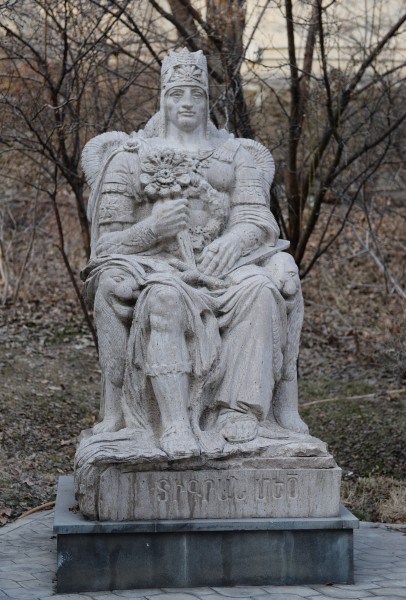
Statue of Tigranes the Great
The Roman Republic saw the danger of such an alliance between the two regional powers, a suspicion which was confirmed by a joint Tigranes-Mithridates campaign against the Roman client state of Cappadoccia. The Romans responded by attacking Pontus, and when Mithridates fled to the court of Tigranes in 70 BCE, they asked for the former to be handed over. When Tigranes refused, the Romans invaded Armenia. Tigranes was defeated by a Roman army commanded by the general Licinius Lucullus right outside the walls of the capital. Tigranocerta was then besieged in October 69 BCE as described by the 2nd-century CE historian Appian in his Mithridatic Wars :
[The Romans commanded by Sextilius] plundered the palace outside the walls, drew a ditch around the city and tower, moved machines against them, and undermined the wall. While Sextilius was doing this, Tigranes brought together some 250,000 foot and 50,000 horse. He sent about 6,000 of the latter to Tigranocerta, who broke through the Roman line to the tower, and seized and brought away the king's concubines. (17:84)
The siege, nevertheless, continued and following the betrayal of the Greek garrison, Tigranocerta was captured and sacked.The conquering Romans were amazed at the wealth of Tigranocerta even after Tigranes had already managed to spirit away part of his royal treasury and personal harem. The looters found 8,000 talents in gold while each Roman legionary received 800 drachmas. The inhabitants abandoned the city following its destruction, many of whom, of course, had been forcibly put there in the first place and were only too glad to return to their homelands.
THE CONQUERING ROMANS WERE AMAZED AT THE WEALTH OF TIGRANOCERTA EVEN AFTER TIGRANES HAD ALREADY MANAGED TO SPIRIT AWAY PART OF HIS ROYAL TREASURY.
Lucullus then moved to attack the important city of Artaxata, but with winter coming on, his supply line dangerously thin and exposed, and even a mutiny amongst his own troops, the Roman general was forced to withdraw. Tigranes' army harried the retreating Romans using guerrilla tactics, and Lucullus was recalled to Rome in 67 BCE. The respite would not last for long as the Roman Senate proved determined to stamp its authority on the region once and for all. In 66 BCE another Roman army headed eastwards, this time led by Pompey the Great. Roman victories followed, and Tigranes was shorn of his empire and forced to pay a huge tribute to Pompey. Armenia was made a protectorate of Rome, but at least Tigranocerta was rebuilt by Pompey and then reinhabited.
ROMAN-PARTHIAN WAR 58-63 CE
The city once again found itself under attack during the Roman-Parthian war of 58 to 63 CE. Armenia was, yet again, disputed territory in a greater game of empires, and in 54 CE the Roman emperor Nero (r. 54-68 CE) sent his best general Gnaeus Domitius Corbulo to assert Rome's position in the region following the attempt by Parthian king Vologases I (aka Vagharsh, rc 51- up to 80 CE, dates disputed) to put his own brother Tiridates on the Armenian throne.

Parthian Archer
During the campaign Tigranocerta, then the country's second most important fortress city after the capital Artaxata, fell to the Romans in 59 CE:
Soon afterwards, Corbulo's envoys whom he had sent to Tigranocerta, reported that the city walls were open, and the inhabitants awaiting orders. They also handed him a gift denoting friendship, a golden crown, which he acknowledged in complimentary language. Nothing was done to humiliate the city, that remaining uninjured it might continue to yield a more cheerful obedience. (Tacitus, Annals, Bk. 14:24)
By 60 CE, Corbulo could claim to rule over all of the Kingdom of Armenia and Tiridates was forced to flee back to his brother in Parthia. In the same year, Tigranes V (rc 60-61 CE), who had impressive royal connections being the grandson of Herod the Great, was set on the throne as a pro-Roman monarch. Tigranes V's cameo reign came to an abrupt end when the Parthians sent an army to besiege him in Tigranocerta in 62 CE. The city held out, but when Corbulo returned to the field from Syria in 63 CE, his presence alone persuaded Parthia to sign the Treaty of Rhandia. Under this treaty, it was agreed to equally share the responsibility of ruling Armenia between Rome and Parthia.
LATE ANTIQUITY
Continuing as an important regional city over the next few centuries, Tigranocerta came directly under Roman governance in 387 CE following an agreement between Rome and the Sasanian Empire. The new overlords then renamed the city Martyropolis. In 536 CE, when the Byzantine emperor Justinian I reorganised the administration of the region, Armenia was split into four areas or provinces and Martyropolis made capital of Armenia IV. In 640 CE, when the Arab Umayyad Caliphate conquered Armenia, the city was renamed again, this time Mayarfarkin.
This article was made possible with generous support from the National Association for Armenian Studies and Researchand the Knights of Vartan Fund for Armenian Studies.
LICENSE
Article based on information obtained from these sources:with permission from the Website Ancient History Encyclopedia
Content is available under License Creative Commons: Attribution-NonCommercial-ShareAlike 3.0 Unported. CC-BY-NC-SA License